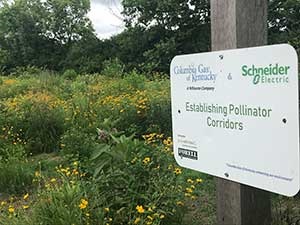
During National Pollinator Week, June 19-25, America celebrates the critical role of bees, bats, and butterflies in feeding the world and highlights efforts to protect them from their worst enemies – land development, climate change, pesticides and invasive species. That’s why Columbia Gas is proud to announce the expansion of a pollinator program that transforms sections of its utility rights of way (ROW) into special pollinator habitats.
The company has added two new pollinator sites to the program this year. The sites, set to bloom for the first time this year, brings to seven the number of ROWs the company has converted by removing existing vegetation and planting a specialized seed mixture that will grow plants like milkweed, Gray Goldenrod, baby’s breath and White Prairie clover.
The Columbia Gas pollinator sites, four of which are certified as monarch waystations, are marked with signs and flags at the following locations:
- Along Georgetown Road at Citation Boulevard in Lexington, behind the Boyd CAT Dealer
. - Across from the Kentucky Vietnam War Memorial on Coffee Tree Road in Frankfort
- At the corner of Man O’ War Boulevard and Versailles Road at the Blue Grass Airport
- On University of Kentucky property at the corner of Research Park Drive and Legacy Trail in Lexington
- At the Kentucky American Water tower site on Mercer Road in Lexington
- On Leestown Road at the entrance to Masterson Station Park in Lexington
- On the inner loop of the Bypass in Georgetown near US 62
Columbia Gas President and COO Kimra Cole said the project reflects the longstanding commitment of Columbia Gas and its parent company, NiSource, to environmental stewardship. The site conversions bolster the company’s goal to reduce its carbon footprint and mitigates maintenance costs and the use of vegetation control measures like herbicides that can harm the ecosystem. Columbia Gas is responsible for maintaining the ROW over about 2,600 miles of natural gas pipelines.
“Finding new ways to do our work while protecting the environment is vital to our company and our industry,” Cole said.
Kentucky State Apiarist Tammy Horn Potter with the Kentucky Department of Agriculture, or KDA, applauded Columbia Gas’ commitment to sustainability.
“When corporations increase pollinator habitat, pollinators have access to improved nutrition and can increase their numbers,” she said. “This project is an exciting model to be emulated everywhere, and Kentucky is really fortunate to have such conscientious efforts to increase pollinator landscape.”
For more information, please see the FAQs below.
Pollinator Program FAQ
What is a ROW?
Utility rights of way (ROW) are designed for the safe and reliable transport of natural gas, oil, electricity and other energy sources. Columbia Gas’ distribution network consists of about 2,600 miles of buried natural gas pipelines in the state of Kentucky. For the most part, the land on which these pipelines are buried is not owned by Columbia Gas, although Columbia Gas has the right to access and maintain the vegetation through a ROW contract with property owners that grants the company a legal right to perform inspections and maintenance.
Where are the seven Columbia Gas pollinator sites?
- Along Georgetown Road at Citation Boulevard in Lexington, behind the Boyd CAT Dealer
. - Across from the Kentucky Vietnam War Memorial on Coffee Tree Road in Frankfort
- At the corner of Man O ’War Boulevard and Versailles Road at the Blue Grass Airport
- On University of Kentucky property at the corner of Research Park Drive and Legacy Trail in Lexington
- At the Kentucky American Water tower site on Mercer Road in Lexington
- On Leestown Road at the entrance to Masterson Station Park in Lexington
- On the inner loop of the Bypass in Georgetown near US 62
What if I want a pollinator site on my property?
If you own land which contains a Columbia Gas pipeline and are interested in creating a pollinator habitat over that pipeline, contact our Vegetation Management Team at pollinatorprogram@nisource.com.
What is included in the pollinator seed mixture?
Kentucky-based native seed company Roundstone assisted Columbia Gas in designing the pollinator seed mixture that includes plants like Purple Prairie clover, black-eyed Susan, White Prairie clover, wild quinine, Indian blanket and Butterfly milkweed. Detailed attention was given to selecting local native annual and perennial plants that are low growing, beneficial to pollinators and flower throughout the seasons.
Who will maintain the project sites?
Depending on what plants thrive in certain areas and what plants do not, pollinator habitat areas will change over time. Biodiversity intensity as well as the length of flowering duration will shift from year to year. Certain maintenance activities will be required to guide these changes. Columbia Gas and NiSource will be responsible for the associated maintenance of the pollinator habitat sites.
What contractors are involved?
Contractors involved with the Columbia Gas pollinator program include:
- Grow With Trees (GWT) provides eco
-logical solutions for ROW maintenance practices. The company has partnered with NiSource, Columbia Gas’ parent company, to develop a corporate-wide Sustainable ROW Management Plan that strategically combines environmental stewardship and ROW vegetation management practices, enabling NiSource to be an industry leader in bringing additional value to its customers. - Arbormetrics Solutions conducts vegetation planning for Columbia Gas companies in Kentucky, Ohio, Virginia, Pennsylvania and Maryland.
- Forell Innovation, a vegetation management company, helps maintain ROW for Columbia Gas companies in Kentucky, Ohio, Virginia, Pennsylvania and Maryland.
- Team Fishel helps maintain ROW for Columbia Gas companies in Kentucky, Ohio, Virginia, Pennsylvania and Maryland.

